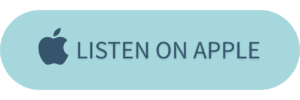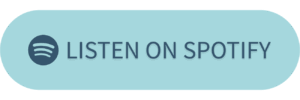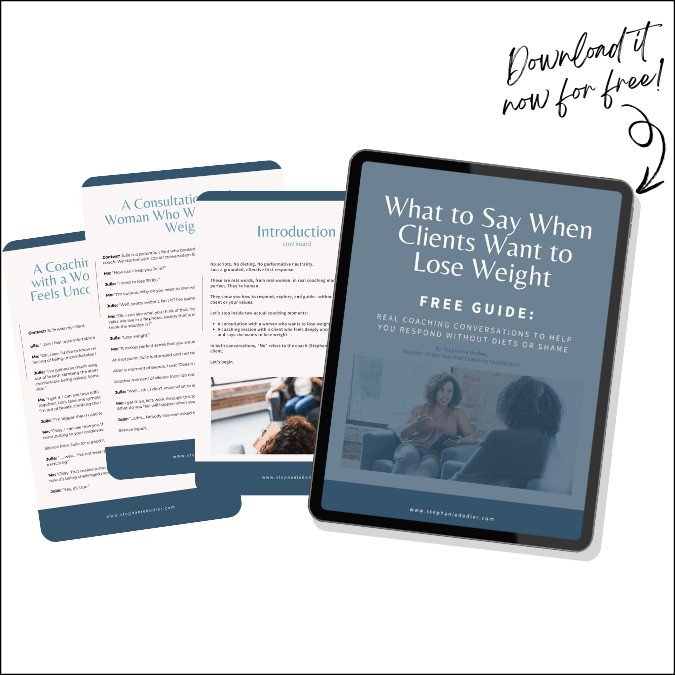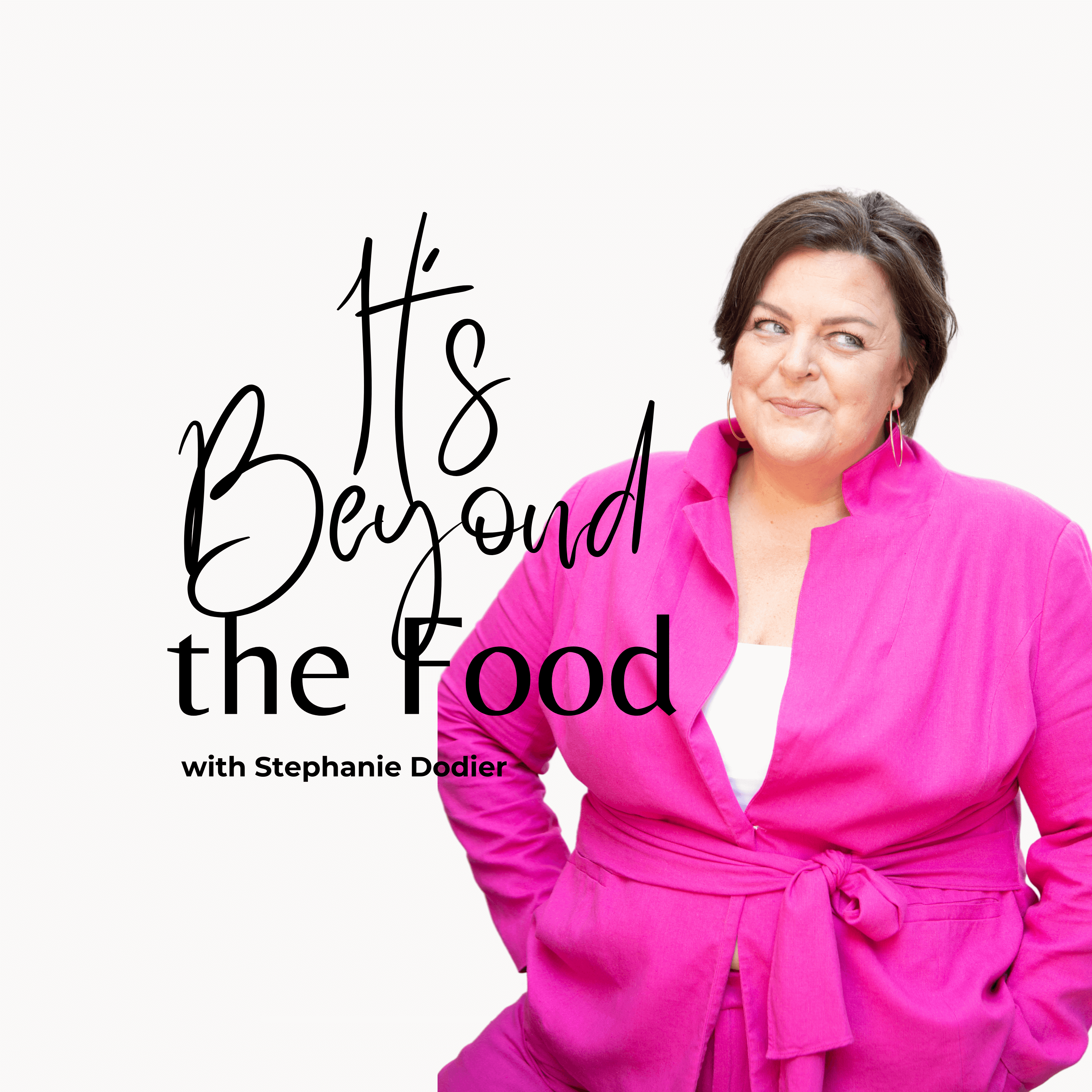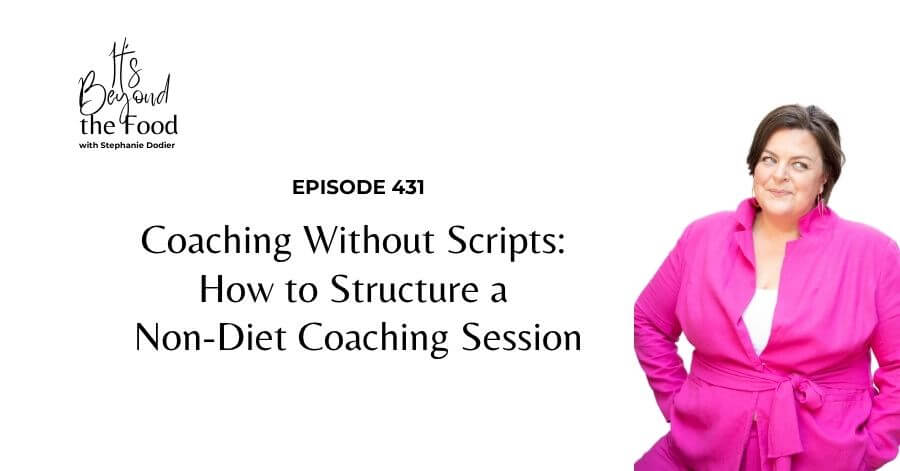

Feeling Confident in Your Non-Diet Coaching Sessions
Ever feel like you’re just winging it in your coaching sessions? In this episode, I share how to move from self-doubt to rock-solid confidence by building a structured, repeatable coaching system. This isn’t about giving out more tips or regurgitating info you found on Google. It’s about delivering real results using a powerful coaching structure that supports both you and your clients.
I walk you through the difference between information delivery and true coaching, and why AI will never replace the emotional intelligence and human connection you bring to your sessions. You’ll get a behind-the-scenes look at how I teach the structure and process that make Non-Diet Coaching Sessions effective—and profitable.
Episode Timeline & Highlights
[1:12] – Why structure matters more than ever in building coaching confidence
[3:50] – The coaching industry’s shift: Why information alone is no longer enough
[6:05] – What clients really pay for in a post-AI world
[10:12] – Understanding the difference between coaching process and coaching structure
[12:55] – Identifying your coaching structure and processes to support specialization
[17:00] – The “Learn, Build, Have” coaching model explained
[21:15] – How minimum baseline habits reveal deeper coaching opportunities
[24:20] – Embodying habits to sustain long-term client transformation
[28:50] – Using this structure to confidently market and deliver real results
Mentioned in the show:
Episode 422: My Predictions for the Coaching Industry in 2025
Episode 423: How to Go Deeper with Your Clients in 2025
Non-Diet Coaching Certification Waitlist
Non-Diet Coaching Client Assessment Tool
Weight-Neutral Coaching Training
Full Episode Transcript
This transcript was auto-generated and lightly edited for clarity.
Click to expand the full transcript
Stephanie: Welcome to It’s Beyond the Food Podcast, my sisters. I’m your host, Stephanie Dosier, and today we’re gonna talk about feeling confident in delivering a coaching session. ’cause that’s one of the biggest thing that keeps professional and coaches feeling confident is having a structure, having organized process that welcomes their client in and allows them as a professional or coach to deliver.
Stephanie: The result that their clients are paying them for. So when you don’t have that structure, that process, that organization to how you deliver client result, it’s absolutely normal that you feel. Not confident that you have doubt and the byproduct of that when you feel doubtful and not confident, is you end up not [00:01:00] marketing yourself.
Stephanie: You end up not putting yourself out there. So when I coach people in business, one of the thing that always gets in the way is. Being out there. And when we dig using our coaching process, we find exactly what I’m gonna teach you today. A lack of structure, a lack of organization to how they’re going to support achieving a goal, and especially for those coming out of the world of.
Stephanie: What I call a traditional health coaching that’s either is directly around weight loss or tinted by the potential weight loss or natural weight loss, not having macros or calories or progress like measurable in number progress, there’s this feeling of like, what am I doing? What am I gonna coach them on?
Stephanie: What am I [00:02:00] gonna hold them accountable to if I no longer do? The way that I was taught. So this episode is to solve all these problems. Okay? It is to show you what is possible. I’m gonna take you in to how we teach a process in a structure, which are two different things inside of the non diet coaching certification.
Stephanie: Obviously I can’t teach it to you in Integrality today, in a 30 minute podcast when it’s a. Five month training with hundreds of hours of practicum and curriculum. You understand that? So we’re gonna go high, high level here, but I wanna show you what it could look like so that you feel comfortable going out there, marketing yourself, and earning a great profit in your coaching business.
Stephanie: I wanna take us back before we go into the, structure and the [00:03:00] coaching process. Understanding the difference between delivering information and coaching. These are two different things, and if you’ve listened to podcast 4 22, which was my prediction for our industry in 2025, I talked about this.
Stephanie: I talked about what’s in front of us. In the coaching industry globally because of AI and artificial intelligence, right? So if your business right now, your coaching business is about lack of a better word, regurgitating information that is available on the internet in a book, in a podcast, and that’s what people pay you for.
Stephanie: Then for sure your business is at risk because that information was already present on Google. But AI [00:04:00] now is organizing it in a way that people will not buy to receive information. What people will invest in is coaching the support, the structure, the handholding, to actually implement the information.
Stephanie: In their life, people are gonna pay for your emotional intelligence, for your ability to nuance. The information they’re getting from Google and AI and apply it individually to them in their identity, given their unique past experience, their unique traumatic experience, all of their identity, be it gender, be it sexual orientation, being race, being cultural background.
Stephanie: Right. They will pay to adapt this information to them and have the human connection, the [00:05:00] support, because right now I can’t say that in the future, AI will never be replacing human connection because I can’t predict that far up. But I can tell you for now, for the next five years, AI will not replace a human connection
Stephanie: personally, I don’t believe that AI will ever replace the ability of human connection to co-regulate, to nuance information, to adapt processes to each individual human being, or each individual client that we have. So you have to be clear for you what you sell in 2025 forward is. The adaptation of the information, the building of resilience with your client to implement and embody the information so that they can get the result, the desire.
Stephanie: So it is true that [00:06:00] if your session are built around education. And information and tips and plans. Accountability, check-ins . Very black and white information. Then your business is at risk and you could potentially feel even more doubtful today. Even got an email recently from a follower who said that she actually stopped selling coaching a couple years ago because when she realized that she was not gonna sell weight loss anymore, she had no idea what to do and she was terrified to put herself out there.
Stephanie: And she will now be joining our program probably in the next three months to learn how to coach and individualize this information with their client. The key for you to feel confident to go out there is having a repeatable process to [00:07:00] help your client and a structure to deliver each session. So that you can coach anything that your client brings to you in the way to their goal.
Stephanie: So what we’re gonna talk about right now in the next 15, 20 minutes, I’m hoping 15 minutes, we’ll see how well I do with time. My goal is for you to no longer think, I don’t know what to talk about in every session, especially if I’m not giving advice and giving a template and reading from a book. I don’t wanna feel like I’m rambling and having to over prepare for every coaching session.
Stephanie: ’cause that is such a reality for many, especially new coaches and new professionals that come into their profession, which we spend way too much time preparing, which makes you unprofitable from a business perspective because you end up prepping for [00:08:00] 90 minutes before the session, delivering the session for 50 to 60 minutes.
Stephanie: And then. Doing notes after the session and sending an email to a client, you end up for every session working two, three hours. And I can totally understand why you think, but this is not something I want to do for the rest of my life with a structure in the process, and I’m gonna. Speak to you right now.
Stephanie: I don’t wanna say the word teaching, but I’m gonna introduce you to different processes and structure here. The goal is that every session you take five to 10 minutes before the session to like get yourself regulated, get yourself in a place of being a coach, and you can just start the zoom session and end the zoom session and not have to do anything else before, after. Especially, I’m gonna take myself a note because I can’t forget to talk to you about AI that [00:09:00] replaced note taking.
Stephanie: Let’s talk about a structure, a coaching structure and specific processes that we teach inside of the non diet coaching certification that makes. Coaching a repeatable process and that builds confidence. I wanna help you understand the difference between a coaching framework and a process.
Stephanie: And I want you to think, if you’re watching me on YouTube, you’re seeing my hands right now, but if you’re listening on the podcast, I want you to think as an umbrella. You know, you walk in the rain. The coaching process is like the umbrella you’re holding above you. You are the process and the coaching structure is the umbrella protecting you from the rain.
Stephanie: A coaching structure sits on top of a process. Here’s another analogy. A coaching [00:10:00] structure is applicable to different specialty that it is coaching soccer. I am using this example right now because I have someone that I know who just got named as the head coach of a woman’s soccer team, and it just came to my mind right now.
Stephanie: ~So, a coaching structure. ~She coaches soccer at a professional level and she uses a coaching structure, coaching framework to deliver the specialty of soccer playing. We, me, in my field as a nutritionist, I use cognitive behavior coaching to deliver nutrition and eating behavior modification,
Stephanie: I use cognitive behavior to deliver, very specifically in my case, intuitive eating. So the coaching structure is how you deliver the process. And I’m gonna use [00:11:00] another example for fitness coaches. So I have many fitness coaches in my world. They mainly deliver a process called functional fitness.
Stephanie: So they use cognitive behavior coaching as a coaching structure to deliver the process of functional fitness. So the question you wanna ask yourself at this point is, what is my coaching structure? The coaching framework that I use to deliver my process? ~Are you, ~and a process could be for you, intuitive eating could be.
Stephanie: Health at every size. Could be functional coaching, it could be medical nutrition if you’re a dietician. Could be behavior modification if you are a therapist. , It could be body neutrality. Body neutrality is a process, a therapeutic process to help people. [00:12:00] Eradicate body dissatisfaction and heal their body image.
Stephanie: So we use cognitive behavior coaching to deliver body neutrality. So what is my coaching structure? What is my coaching framework that I use to deliver my process? What are my processes that I use in my specialty? So again, if you refer back to podcast 4 22. And also 4 23, which is both published in January, 2025.
Stephanie: I say in 4 22 that the number one way to continue to grow your coaching business in 2025 forward is specialization. In 4 22, I teach you how to go deeper with your client and your specialty. So what are the process in your specialty you’re using? Identify those. This is how you help people solve the problem that is specific to your [00:13:00] business.
Stephanie: For an example for me, when I was working with general population. The problem that I was solving with people was getting off dieting, the presentation that people had was binge eating, emotional eating, any kind of rebellious eating. I helped people solve that problem using the process of intuitive eating, and I facilitated the process of intuitive eating.
Stephanie: Using cognitive behavior coaching. I want you to fill in the blank here. What problem do I solve specifically for my ideal client? What process do I use to solve these problem and how do I facilitate this process with my client quickly? The process we use, ~cognitive behavior coaching is a there, blah, blah, blah.~
Stephanie: Cognitive behavior coaching. So what is cognitive behavior coaching? It is a coaching approach that combines the principle of [00:14:00] cognitive behavior therapy with various coaching technique that helps people achieve their goal. So cognitive behavior coaching is a framework that helps people identify their thoughts.
Stephanie: And how their thoughts influence their feelings and how they’re feeling produce the behavior that is in their way of achieving their goal and helps them develop the behavior that they need in order to achieve. The goal that they want. So we identify the behavior that’s in the way of their goal, and then we help them create a new behavior that’s gonna help them achieve their goal.
Stephanie: The difference between cognitive behavior coaching and cognitive behavior ~therapy ~therapy is the frameworks that use within the license. Therapy social worker psychotherapist, and that ~pre ~predominantly helps people go back in their past and it helps them ~through C-B-C-B-T, sorry, ~through [00:15:00] CBT, identify in their past what influenced their current behavior today in a framework of coaching where we are not licensed to deliver.
Stephanie: Therapy or license to deliver psychotherapy. We stay in the present moment, ~right? ~We use the thoughts and the feeling in the present moment and how they influence the current behavior they no longer want to have and create the new behavior they want to have. So that’s cognitive behavior coaching.
Stephanie: When we use that coaching structure. We wanna look at the achievement of the goal of our client in kind of three phases, learn, build, and have. So if you think of a client that’s coming to you to solve, we’ll take ~my, ~my old specialty binge eating for an example, and I was selling a six month coaching program,
Stephanie: so six [00:16:00] months, it was an average of three session a month. For 18 session, I have three phases with my client. If you divide the 18 session into three phases, I was probably spending three session at the beginning learning from my clients. The learn phase, and this is where I would create their goals with them.
Stephanie: Again, creating a goal is something that, I don’t know why it’s not being taught in some training program. They don’t have a framework to create goals, we have that in the non diet coaching certification. We teach my framework that’s called the Liberated goal Process, which is specifically designed for women with feminist principle on how to have a brand new.
Stephanie: Perspective on setting goals. We use that framework. Within session one and two, we [00:17:00] create goals with our clients using, again, another process. So you don’t feel like, oh, like how am I gonna set my goals with my client? No, you have a step. 1, 2, 3, 4, 5. You use that to set up your goal. Then we evaluate why they’re not having the goal yet.
Stephanie: Within each area of life or skillset that contributes to the goal, how are they doing? If I go back to binge eating where I was before, there was three area that I had identify that contributed the most to their eating behavior. Number one was their eating behavior. Number two was body image.
Stephanie: Remember, I was specializing in helping women leaving diet culture, leaving dieting behind. Or weight loss behind. So definitely [00:18:00] body image was a skillset that they didn’t have or were performing very poorly in their body image. So I evaluated their body image, evaluating their eating behavior. And the third component for me was their mindset.
Stephanie: The way that they were thinking, their perspective on health, on food, on body image. And I had to evaluate their mindset, identify their gap. And through the next phase, which is build help them build the skillset that we’re lacking so that they have the habit to create their goal.
Stephanie: So I repeat that in the learn phase, which is typically session one to three, we create the goal with your client live in the session, and then. We evaluate. So do you have a goal setting process that you can repeat client to client, to client? [00:19:00] And do you have an evaluation of very specific area, skillset of life that you can evaluate your client and take every client through this evaluation process?
Stephanie: The last piece of the learn, because we use cognitive behavior coaching, is identifying why they’re not having the habit right now. What are their thoughts and belief that creates the feeling that produce the undesirable habits? That creates the reality they no longer want.
Stephanie: What are their thoughts and their belief that creates the shame, the guilt, the anxiety around food and body image that creates their binge eating today. That was the third piece of the learned phase that I would do with every client using cognitive behavior [00:20:00] coaching is identifying the belief system.
Stephanie: The recurring thought patterns that created their feeling and their binge eating habits. That’s the learn phase, and that is a maximum of two tore session. The more experience you have at applying your process, the more effective you are and the more repetition you’ve put yourself through as a coach will go faster, obviously.
Stephanie: That second phase is the longest phase of your coaching structure and framework, which is building. This is where you build the habit. This is where you build the new belief. This is where you help your client create new thought patterns and coach on all the things that get in the way of implementation of the habit.
Stephanie: Now in my world, I [00:21:00] have a few tools that helps the implementation. One of them is what we call minimum baseline. So when we enter the phase of building with our client, we pick one habit at a time and we go for the minimum baseline. So for an example, if we’re thinking about moving our body, and I always use this one because is where client will resist the most.
Stephanie: We start with going for a walk once to twice a week a walk of like 15 to 20 minutes. That’s what’s we call minimum baseline, the minimum baseline we can do, the minimum amount of the habit we can do so that we can identify what gets in the way. And that’s was very difficult for client in my world because they came from this black and white thinking around moving their body,
Stephanie: they use exercise to lose weight and it was [00:22:00] go all in or don’t go at all. So they went from not moving their body to going to the gym five days a week. So we reset that to the minimum baseline and until they were able to go for a walk. Twice a week for 15 minutes. We weren’t escalating the behavior or the habit because ~we ~through the minimum baseline, we identify what got in the way of them being consistent.
Stephanie: Before that, it is time management, family structure, family organization, resiliency skills. Right motivation factor. So we have to identify what gets in the way of doing the minimum baseline of the one habit so that we can escalate the habit after to where it needs to be to get them the result that they desires.
Stephanie: For an example, when we think about moving our body, we’re looking at moving our body based on the standards. Which are the American [00:23:00] standard, and I think the European standard are very close to, it’s 120 minutes a week of specific movement, right? So we’re talking about three session of specific movement a week, going on a walk, minimum walk, whatever.
Stephanie: And this is goals that we create very specifically for our client. But first we hit the minimum baseline. And let me tell you. This is where cognitive behavior coaching comes in because this is where we identify and create changes beyond the food. In my world, that’s where the word beyond the food came from, because this is where you find yourself talking about prioritization.
Stephanie: This is where you talk. You end up talking about relationship. You end up talking about time management. You end up talking about values. Because in order to implement new habits in the life of someone, something’s gonna come off the schedule. And this is where the Liberated goal framework that I was talking to you [00:24:00] earlier ~is, ~was specifically created for women because women are taught to not get anything off their lists, to just keep adding and being quote, more productive.
Stephanie: Gotta cut that bullshit in my world. In order for us to implement a new habit, something had to come off, and that’s emotionally difficult for my ideal client that were women, so we ~had to move our coaching, ~had to move through that and help our client. This is where we lean back. Into our coaching structure, which is cognitive behavior coaching.
Stephanie: What are you thinking about your relationship? What are you thinking about time? What are you thinking about saying no? What boundaries do you need to put in place? And that’s where we use cognitive behavior coaching to do this. ~The, ~the last phase of a coaching package, once we got through the learn.
Stephanie: We got through the bill is having, I call it have, we [00:25:00] are easily embodying in our life. The habits. We are easily moving our body. We are easily following our hunger, fullness cue. We are easily, if I’m ~a, ~a fitness instructor, stretching. In a regular basis in order to gain mobility so that you can build the muscle so that you can be strong as you grow holder or being strong at any weight,
Stephanie: but we need to implement the stretching in order to create the mobility. Not gonna get into. Fitness, because that’s not my zone of expertise, but that’s what I hear all the time when people are studying with me that are talking. So having those habits, being in the new version of yourself that has created the space in their life, that have identified their value, that are easily [00:26:00] embodying their priority so that the habit.
Stephanie: That will create your goal is sustainable for the rest of your life. That’s how we structure a coaching package, ~a coaching, ~a program using your coaching structure and the various processes that ~sits ~within those structure. So within the learn and within the build phase. That’s for dietician and nutritionist.
Stephanie: That’s when we deliver. The intuitive eating framework, that’s how we’re gonna take our client from binge eating habits to normal eating pattern or intuitive eating pattern by going through the 10 principle of intuitive eating hunger, fullness, satisfaction, diet, mindset, all the things. So if I’m a dietician, a nutritionist, a health coach.
Stephanie: I know exactly what I need to [00:27:00] do. When I onboard a client, I know exactly what I’m gonna do with every client. What we have to go through, the different, skill we need to build. It’s not something like, oh my God, what am I gonna do with this client? I have specific processes that I’m following, and I have a coaching structure, a coaching.
Stephanie: Process that organize all of my methodology that I’m using so that I feel confident that I can help any client within my ideal client circle with specific goal that I’m a specialist for. Get the results so I’m no longer hesitating, telling people in my marketing I can help you achieve your goal. I can help you deliver the result that you want, because here’s what I’m doing.
Stephanie: Top top, top. ~It’s not. ~It’s something that I’m certain that I have the tool, the structure, [00:28:00] the process to help people deliver the result that they want to have now in my world. I’ve taken this process that works so well with my general population client. When I was working with general population and I’m now teaching it.
Stephanie: I am teaching cognitive behavior coaching. I am teaching intuitive eating process. I am teaching a body neutrality process, awake neutral health coaching process, and that’s what my student come out of the non diet coaching certification with. Processes, coaching structures so they can go out there, deliver it exactly as I taught it to them.
Stephanie: If they’re a nutritionist, a dietician, if they’re a fitness instructor, they’re taking part of this and embedding it within their functional fitness processes, [00:29:00] or some of them, what they do is they end up building more comprehensive coaching program. So a fitness instructor who would normally only coach client within the gym for the time they’re doing their workout, they now have a more comprehensive package they can sell to their client in where they’re gonna coach them on their eating behavior using intuitive eating.
Stephanie: They’re going to do some body image work. They could sell it globally with their functional fitness. They can do it separately. There’s people adopting models that are very unique to their business. Same thing for an example. If a therapist is, they will be able to support client with an eating disorder, for an example, using body neutrality.
Stephanie: Or for some of them, they want to. Spread their wings in the coaching [00:30:00] world. So they start offering coaching package, which is different than therapy package. So it could be the non diet coaching certification and the different processes and structure we coach Could be an added program you embed in your business, or it could be added to your current portfolio of product and making it more.
Stephanie: Comprehensive, longer, bigger, more expensive. So there’s different way to look at this based on what you do right now. But at the end of the day, what we teach inside of the non diet coaching certification is a repeatable process and a structure that builds the confidence for people to show up.
Stephanie: And. Make more money. So I’m gonna invite you if you want to learn or if you want to integrate repeatable processes, coaching structure. Join us in the next round of the non diet coaching certification. We have a wait [00:31:00] list. We have special incentive for people in our wait list. Stephanie dosier.com.
Stephanie: Forward slash wait lists. Put your name on there and you will ~be ~receive a special treatment for the next enrollment of the non diet coaching certification. I love you, my sister, and I’ll see you on the next episode.
wanna coach behaviors, not bodies. Learn the mindset tool and the method that create real changes.
Join the wait list for the next cohort of the non diet coaching [email protected] slash waitlist. That’s where the real training begins, and I’ll see you on the other side, my sisters.

